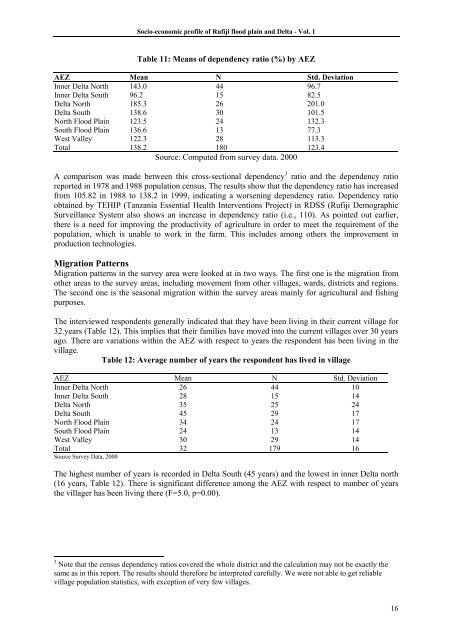A Socio-Economic Profile of the Rufiji Floodplain and Delta.
A Socio-Economic Profile of the Rufiji Floodplain and Delta.
A Socio-Economic Profile of the Rufiji Floodplain and Delta.
Create successful ePaper yourself
Turn your PDF publications into a flip-book with our unique Google optimized e-Paper software.
<strong>Socio</strong>-economic pr<strong>of</strong>ile <strong>of</strong> <strong>Rufiji</strong> flood plain <strong>and</strong> <strong>Delta</strong> - Vol. 1<br />
Table 11: Means <strong>of</strong> dependency ratio (%) by AEZ<br />
AEZ Mean N Std. Deviation<br />
Inner <strong>Delta</strong> North 143.0 44 96.7<br />
Inner <strong>Delta</strong> South 96.2 15 82.5<br />
<strong>Delta</strong> North 185.3 26 201.0<br />
<strong>Delta</strong> South 138.6 30 101.5<br />
North Flood Plain 123.5 24 132.3<br />
South Flood Plain 136.6 13 77.3<br />
West Valley 122.3 28 113.3<br />
Total 138.2 180 123.4<br />
Source: Computed from survey data. 2000<br />
A comparison was made between this cross-sectional dependency 3 ratio <strong>and</strong> <strong>the</strong> dependency ratio<br />
reported in 1978 <strong>and</strong> 1988 population census. The results show that <strong>the</strong> dependency ratio has increased<br />
from 105.82 in 1988 to 138.2 in 1999, indicating a worsening dependency ratio. Dependency ratio<br />
obtained by TEHIP (Tanzania Essential Health Interventions Project) in RDSS (<strong>Rufiji</strong> Demographic<br />
Surveillance System also shows an increase in dependency ratio (i.e., 110). As pointed out earlier,<br />
<strong>the</strong>re is a need for improving <strong>the</strong> productivity <strong>of</strong> agriculture in order to meet <strong>the</strong> requirement <strong>of</strong> <strong>the</strong><br />
population, which is unable to work in <strong>the</strong> farm. This includes among o<strong>the</strong>rs <strong>the</strong> improvement in<br />
production technologies.<br />
Migration Patterns<br />
Migration patterns in <strong>the</strong> survey area were looked at in two ways. The first one is <strong>the</strong> migration from<br />
o<strong>the</strong>r areas to <strong>the</strong> survey areas, including movement from o<strong>the</strong>r villages, wards, districts <strong>and</strong> regions.<br />
The second one is <strong>the</strong> seasonal migration within <strong>the</strong> survey areas mainly for agricultural <strong>and</strong> fishing<br />
purposes.<br />
The interviewed respondents generally indicated that <strong>the</strong>y have been living in <strong>the</strong>ir current village for<br />
32.years (Table 12). This implies that <strong>the</strong>ir families have moved into <strong>the</strong> current villages over 30 years<br />
ago. There are variations within <strong>the</strong> AEZ with respect to years <strong>the</strong> respondent has been living in <strong>the</strong><br />
village.<br />
Table 12: Average number <strong>of</strong> years <strong>the</strong> respondent has lived in village<br />
AEZ Mean N Std. Deviation<br />
Inner <strong>Delta</strong> North 26 44 10<br />
Inner <strong>Delta</strong> South 28 15 14<br />
<strong>Delta</strong> North 35 25 24<br />
<strong>Delta</strong> South 45 29 17<br />
North Flood Plain 34 24 17<br />
South Flood Plain 24 13 14<br />
West Valley 30 29 14<br />
Total 32 179 16<br />
Source Survey Data, 2000<br />
The highest number <strong>of</strong> years is recorded in <strong>Delta</strong> South (45 years) <strong>and</strong> <strong>the</strong> lowest in inner <strong>Delta</strong> north<br />
(16 years, Table 12). There is significant difference among <strong>the</strong> AEZ with respect to number <strong>of</strong> years<br />
<strong>the</strong> villager has been living <strong>the</strong>re (F=5.0, p=0.00).<br />
3 Note that <strong>the</strong> census dependency ratios covered <strong>the</strong> whole district <strong>and</strong> <strong>the</strong> calculation may not be exactly <strong>the</strong><br />
same as in this report. The results should <strong>the</strong>refore be interpreted carefully. We were not able to get reliable<br />
village population statistics, with exception <strong>of</strong> very few villages.<br />
16
















